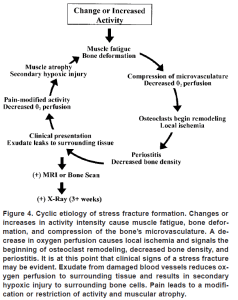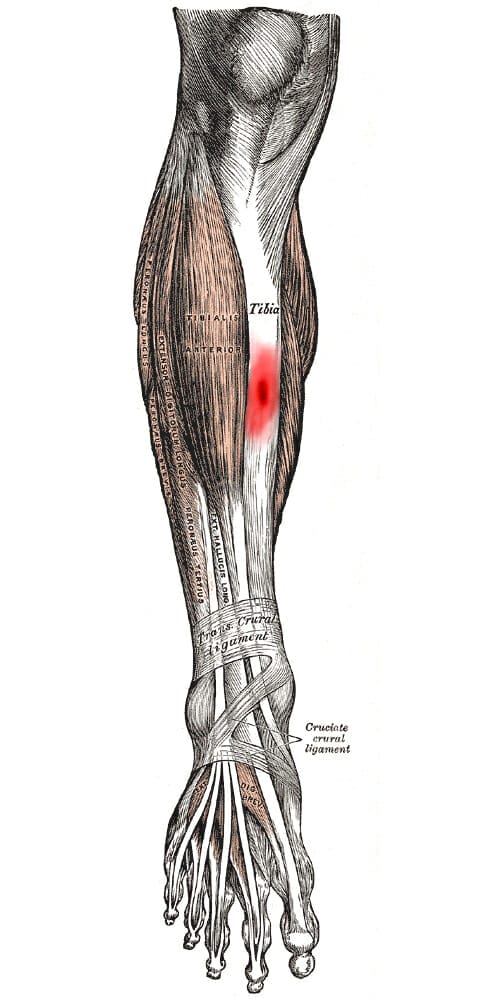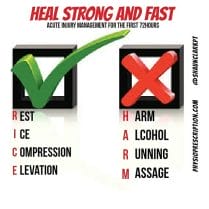 A huge 20% of runners get a stress fracture in foot from running – often when building to a big race! We will try to answer questions like what a stress fracture is, why runners are so prone to them and also how to get them better, faster.(3)
A huge 20% of runners get a stress fracture in foot from running – often when building to a big race! We will try to answer questions like what a stress fracture is, why runners are so prone to them and also how to get them better, faster.(3)
What is a stress fracture?
A stress fracture, as the name suggests, is a small fracture in a bone. It is a partial or incomplete fracture caused by the build up of stress to a localized area of bone.
Stress fractures aren’t your usual fracture that happen due to a big fall or collision, they are due to repetitive strain, which is why runners are so at-risk, but more on that soon.
What causes a stress fracture?
Bones get stressed when there is a load placed through them, whether this is from the shock of your foot landing on the ground or from your muscles pulling on the bones to move you and absorb the shock. Stress fractures can basically be classified into two types:
1. Fatigue; This is caused by an abnormal stress (more than the bone is used to) to a normal bone.
2. Insufficiency; These fractures arise from the application of normal stress through a bone that is abnormal – such as mineral deficient or abnormally rigid. This is most prevalent in nutrient deficient and older population with osteoporosis and arthritis.
Stress Fracture in foot from Running
The type that is most common in the active population, as you can guess I’m sure, is the fatigue stress fracture. Generally the “abnormal force” that causes this bone-fatigue is due to:
- Increasing training intensity or distance,
- Wearing inappropriate shoes or not progressing into new shoes
- Training on hard surfaces or due to poor alignment of the feet
The problem with bones is that they adapt a lot slower than muscles – when muscles can adapt and improve within a few weeks, bones can take a few months! This means that as your muscles improve and your lungs do too, you can go further and faster. The only problem with that is that your bones are still trying to adapt to the initial increase in training. This delta in adaptability can cause stress fracture in foot from running.
Bone Adaptability

Think of bone remodeling like renovating a house: Winter hits, and without thick walls it is bloody cold. So you adapt and decide to insulate the walls.
Your bones are the same, they get an increase in stress through them and think hey, I need to get stronger, but before your bones get stronger, just like insulating your walls, the current walls need to be taken downs first.
The problem is if you increase training load or intensity in this time when the bone is actually weaker, when trying to remodel, you can push it over the edge and cause a stress fracture.
In fact, there’s even a window of about a month where bone becomes weaker after an increase in training stress because of the way the body remodels bone, as described above, which increases the risk of stress fracture in foot from running.
Your body first tears out some walls in the bone structure before it can put in new ones, much like remodeling your house.
Where do Stress Fractures happen?
Stress fractures in runners are most common in the shin bone, the navicular bone in the foot and the 2nd and 3rd metatarsals (long bones in the foot) – stress fractures through these three bones make up over 50% of all stress fractures.(1)
Note: Shin splints does not mean stress fracture. Shin splints is a generalised, umbrella term that is used to describe pain in the anterior shin – this can be a number of things so be sure to have your shin pain diagnosed by a professional.
Why are runners so at risk for stress fracture in foot from running?
Stress fractures account for a massive 20% of athletic injuries and are very common in endurance activities, especially distance running. This is hardly surprising as running requires thousands of repetitive steps on every run – now if you do any of these for example:
- Increase training mileage too fast (more than 30% in two weeks for example)
- Start using new minimalist shoes all of a sudden
- Increase training intensity
Just to name a few! This will be putting more load through your bones than they are used to. If they then aren’t given time to adapt to this and get stronger – they will actually suffer repeated micro trauma and will fracture
A stress fracture typically feels like an aching or burning localized pain somewhere along a bone. Usually, it will hurt to press on it, and the pain will get progressively worse as you run on it, eventually hurting while walking or even when you’re not putting any weight on it at all.
Sometimes, if the stress fracture is along a bone that has a lot of muscles around it, like the tibia or femur, these muscles will feel very tight.
How to heal strong and fast and get back to running ASAP.
Firstly, get it diagnosed by a professional. The vast majority of stress fractures heal within 8 weeks, but it is important to have it diagnosed as soon as possible so that yo know for sure what it is.
Secondly, rehabilitation of a stress fracture can be split into three phases:
Phase 1: Relative rest (rest and protect phase)
The goal in the first phase is to rest the injured area to give it time to heal, while maintaining aerobic fitness. This is the main goals:
 Rest the injured area: No running or loading up the area. Listen to it, if it hurts, stop. A moon boot may be needed and will definitely help you heal strong.
Rest the injured area: No running or loading up the area. Listen to it, if it hurts, stop. A moon boot may be needed and will definitely help you heal strong.- Maintain fitness through swimming and cycling
- Seek treatment from a physio – This does help as it is important to maintain full range of motion and to unload the injured area
- Ice to decrease inflammation and limit secondary damage
- Do not take anti-inflammatory medication if you can help it (you don’t want to stop inflammation and slow healing)(2)
Phase 2: Strength, conditioning and rehab for stress fracture in foot from running
In this stage we need to ensure the causative factors behind the injury are sorted out. Things such as, tight muscles, muscles with poor endurance or controlled and training error.
This is the phase that you will enjoy as unlike the first phase, it isn’t all rest and unload – You can take control of your recovery by doing the right rehab exercises to ensure the stress fracture heals strong and fast. Your exercises need to address these areas:
- Increase muscular endurance (calves, glutes and hamstrings)
- Improve core and pelvic stability
- Work on balance training (proprioception)
- Address flexibility issues
- Re-train running pattern
Phase 3: Safe progression back to full activity
This is where you ease your body back into it while allowing the bone to strengthen and heal – without overloading again.
In the second blogpost in this stress fracture series, I am going to detail phase 2 and 3 – the exercises that you can do to help speed up recovery and have you healing strong. These are all exercises that can be done at home so there is no excuse for them not being done!


 Rest the injured area: No running or loading up the area. Listen to it, if it hurts, stop. A
Rest the injured area: No running or loading up the area. Listen to it, if it hurts, stop. A